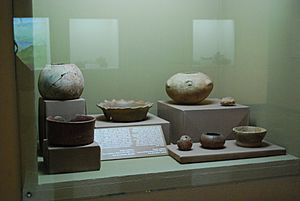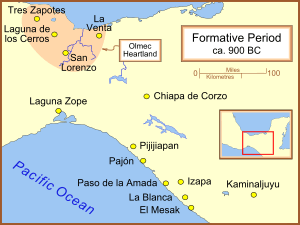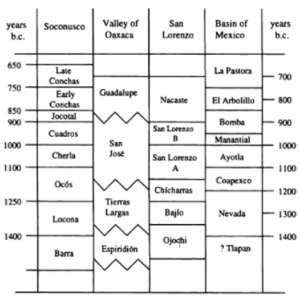Mokaya facts for kids
Quick facts for kids Mokaya |
|
|---|---|
| Pre-Olmec culture | |
| Location | Soconusco region in Mexico and parts of the Pacific coast of western Guatemala |
| Language | Mixe–Zoquean |
The Mokaya were an ancient culture that lived in the Soconusco region of Mexico and parts of Guatemala. They were one of the first groups in Mesoamerica to build settled villages. This happened even before the famous Olmec civilization became powerful.
Archaeologists created the name Mokaya. It means "corn people" in an old language called Mixe–Zoquean. This was likely the language the Mokaya spoke.
The Soconusco region is a coastal area. It has three main parts:
- The Lower Río Naranjo area in Guatemala.
- Acapetahua in Mexico.
- Mazatán in Mexico.
These areas are about 50 kilometers apart. But they were connected by a natural waterway. This made it easy for people to travel and communicate long ago.
The Mokaya Timeline: When They Lived
The Mokaya lived around the same time as the early Olmecs. The Olmecs were the first people in Mesoamerica to use cacao. Cacao is the plant that chocolate comes from.
Cacao originally grew in the Amazon rainforest. But it was grown by people in this region around 1900 BC. Some evidence suggests the Mokaya were the first to grow cacao around 2,500 BC. Even the word "cacao" might come from the Olmec language.
Archaeologists found proof of cacao drinks at a Mokaya site. This shows they were enjoying cacao a very long time ago!
Early Mokaya: The Barra Phase (1900-1700 BC)
The Barra phase is the earliest part of the Mokaya culture. It lasted from 1900 to 1700 BC. During this time, fancy pottery suddenly appeared. It seems like these pots were first made to look like containers made from gourds.
Some important sites from this time include Altamira, San Carlos, and Paso de la Amada.
Growing Stronger: The Locona Phase (1700-1500 BC)
After the Barra phase came the Locona phase, from 1700 to 1500 BC. During this time, more people lived in the area. Also, the number of Mokaya villages grew a lot.
The Ocos Phase (1500-1200 BC)
The Ocos Phase followed the Locona phase. It lasted from 1500 to 1200 BC. A famous archaeologist named Michael D. Coe studied the pottery from this time. He found it at the village of La Victoria.
How Mokaya Society Changed
The Mokaya are believed to be one of the first cultures in Mesoamerica to develop a society with different levels. This means some people had more power or importance than others. This happened around the late 2nd millennium BCE. It was even a little before similar changes were seen in early Olmec cities.
Life in Mokaya Villages: Key Periods
Archaeologists have studied different periods of Mokaya life.
Barra Phase (1900-1700 BC): Pottery and Chocolate Appear

The Barra phase marks the start of the Early Formative period. It lasted from 1850 to 1650 BC. This is when the first known pottery was made in Mesoamerica.
During this time, the Mokaya mainly lived on the Pacific Coast of Chiapas, Mexico. Their settlements included large villages (15-51 hectares). Smaller villages, hamlets, and homesteads surrounded these larger places.
Most of what we know about Barra pottery comes from Paso de la Amada. A common type of pot was the tecomate. This was a round jar with no neck and a narrow opening. These pots were likely used for drinks, not for cooking.
One special tecomate found at Paso de la Amada had traces of cacao. This pot was used between 1900-1500 BC. It shows that early pottery was used for drinks like chicha, cacao, or atole. These drinks were likely shared at social events. Giving these drinks might have made someone seem more important.
Even though they grew some plants, the Mokaya probably got most of their food by hunting and gathering. This is why their settlements were often near rivers and swamps.
Pottery on the Guatemala Coast
Pottery from the Madre Vieja culture in Guatemala is from the same time. It looks similar to Barra pottery.
This pottery is thick and comes in white, black, or red. It often has a smooth, shiny surface called a ceramic slip. It has been found along the Pacific Coast of Guatemala. Sometimes, the pots have grooves and look like squashes or pumpkins. This pottery dates from 1680 to 1300 BC.
Locona Phase (1650-1550 BC): More Complex Pottery
Around 1650 to 1550 BC, the Mokaya started making a wider variety of pottery. This marks the beginning of the Locona phase. Common pots included open bowls and unslipped tecomates.
By the Locona phase, there were several large villages in the Mazatán area. Some of these villages had big buildings. They also had fancy pottery, small figures, and tools made from obsidian (a volcanic glass).
Some researchers think the Locona phase Mokaya influenced the Olmecs. They believe that simple chiefdoms (societies led by a chief) began in the Mazatán region during this time. This is based on what they found in artifacts, buildings, and regional surveys.
Ocós to Jocotal Phases: Changing Lifestyles
These phases show how Mokaya life continued to change:
- Ocós (1500-1350 BC)
- Cherla (1350-1200 BC)
- Cuadros (1200-1000 BC)
- Jocotal (1000-950 BC)
Most large early settlements continued to be used. Pottery and other items changed quickly from one phase to the next. During the Ocós phase, Paso de la Amada was a large settlement, about 50 hectares in size.
Pottery also grew in size and variety during the Ocós phase. This likely means people were cooking more food. They were also using pots for storage, not just serving. During the Cherla phase, jars became a regular part of their pottery.
Changes from the Locona through the Cherla phases show that plain tecomates and open serving bowls became more important.
During the Cherla phase, the Mazatan area had a strong connection with the Gulf Coast Olmecs. Later, pottery from the Cuadros period looked very similar to early Olmec pottery. It is thought that the Mazatan area came under Olmec control during the Cuadros period.
Changes in pottery shapes, uses, and decorations show that Mokaya society was becoming more complex. Important people in the villages used special pots to show their status. They also used them in feasts to keep their higher position in society.
Conchas Phase (850-650 BC): A Shift in Focus
During the Middle Formative period, especially the Conchas phases (A-C and D), the main settlements moved. They shifted to the Lower Río Naranjo area in Guatemala. Many large early sites near rivers and swamps in the Mazatán area were left empty.
During Conchas A-C (about 850-750 BC), the large center of La Blanca was built. It included a huge earthen mound, 25 meters tall. People at La Blanca and along the coast started eating more maize (corn).
Eating more maize may have led to important social and economic changes. The population grew, and people gathered in larger groups. They also built huge earthen mounds. Relying more on farming helped the population grow and society become more complex. This was something that didn't seem possible in the Mazatán area.
Evidence from diet, technology, and art shows that the Mokaya economy changed a lot during the early Middle Formative Conchas phase.
|



